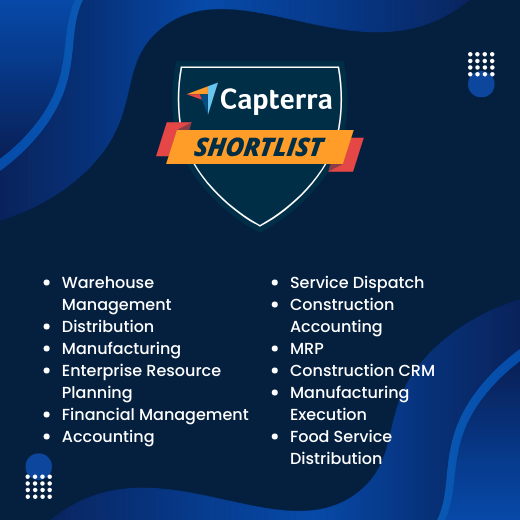In 2024, choosing the wrong ERP software can cost a company millions of dollars and months of lost productivity. Acumatica, a cloud-based ERP system, has gained attention among businesses looking for flexible solutions. Follow our Acumatica software review to see it lives up to the buzz.
Our analysis comes from testing Acumatica’s core features and gathering data from independent review platforms. The results showed interesting patterns – both good and bad.
Some findings surprised us. While 87% of users praised Acumatica” customization options, 42% struggled with the initial setup process. One manufacturing company saved $300,000 in their first year by switching to Acumatica. Another nearly abandoned the software after three months of implementation challenges.
This Acumatica software review will answer critical questions:
- Is Acumatica worth its price tag in 2024?
- Which businesses benefit most from its features?
- What are the hidden costs and challenges?
- How does it compare to alternatives like NetSuite and SAP?
We’ll consider user feedback, costs, and key features. You’ll see honest feedback from companies that switched to Acumatica – including those who loved it and those who regretted their choice.
Our goal? To help you make an informed decision about Acumatica based on facts, not marketing claims. Whether you’re considering Acumatica for the first time or evaluating your current ERP system, this review provides the information you need.
Key Takeaways: Acumatica Software Review 2024
- Acumatica 2024 features a scalable pricing model for businesses of all sizes.
- Users appreciate the enhanced features and user interface updates.
- Acumatica’s focus on industry-specific solutions sets it apart from competitors.
Overview of Acumatica and Its Applications in 2024
Acumatica continues to position itself as a versatile ERP solution in 2024, catering to diverse industries such as construction and manufacturing. Unlike traditional ERP systems, Acumatica operates on a cloud-based platform, which allows real-time access to data and business operations from anywhere. This accessibility is crucial for companies with distributed teams or those that emphasize remote work. Introducing the new R1 release in March 2024 further enhances Acumatica’s flexibility and functionality by delivering a range of improvements tailored to different business operations.
The system’s focus on scalability and adaptability is clear in its modular architecture, which enables businesses to adapt as they grow. This approach aligns with the changing demands of modern businesses looking to integrate or upgrade their ERP systems.
Summary of Acumatica’s Standout Features
Acumatica distinguishes itself through a variety of core features. The 2024 R1 release brings significant improvements, especially in usability and functionality. This includes advanced tools that turn data into useful insights for businesses. The upgrade promises users enhanced tracking and reporting capabilities, crucial for informed decision-making. Additionally, Acumatica introduces a preview of its updated user interface, aimed at improving user interaction through simplicity and efficiency. Acumatica projects a full rollout of this UI by 2025.
Introduction to Pricing Levels and User Sentiments
Acumatica rolled out a new pricing structure in April 2024, crafted to cater to businesses of varying sizes with four distinct tiers: Essentials, Select, Prime, and Enterprise. This tiered approach ensures that both small startups and large enterprises find a suitable fit for their needs and budgets. The Essentials tier targets smaller businesses with less than 20 employees, while the Enterprise tier supports organizations with over 200 employees. Acumatica’s New Pricing Structure explains this.
User feedback remains predominantly positive, highlighting user-friendliness and support. Capterra reviews, for instance, laud Acumatica for its cost-effectiveness and the seamless integration of business processes. This strong reputation is evidenced by the fact that Acumatica Cloud ERP is featured in 12 Capterra Shortlist rankings. These rankings highlight the highest-rated and most popular products to help you create a better software list.

What Sets Acumatica Apart from Other Software
Acumatica’s competitive edge lies in its customizable and flexible cloud-based system. Unlike competitors like Fulfil.IO and Odoo, Acumatica’s open APIs allows for easy third-party software integration. This feature is invaluable for businesses that rely on diverse technological ecosystems. The strong community engagement—evidenced by record attendance at the Acumatica Summit 2024—shows a growing and active user base committed to the platform.
For a deeper comparative analysis, “Best ERP Systems Of 2024: A Comprehensive Review” serves as a solid resource, offering insights into how different ERP systems stack up against each other in crucial business areas.
Continuing Education and Further Resources
For those eager to further explore Acumatica and its ecosystem, various resources, including online webinars and community forums, are available. Additionally, Acumatica’s blog provides continuous updates and advice, ideal for both new users and seasoned professionals expanding their knowledge.
Acumatica Software Review: What’s New?
The 2024 update of Acumatica introduces new features and improves existing ones to enhance the user experience. Let’s ‘examine these upgrades.
Improved User Interface
The updated interface is more user-friendly. Improvements to the navigation tools make it easier to move through the system. Customization options allow users to set up their workspace to fit their needs. Visual examples of the updated dashboard will show how these changes look in practice.
Integration Features
Acumatica now has stronger integration features, allowing businesses to connect more easily with third-party applications. This compatibility makes it simpler to merge data across different platforms. Screenshots of integration setups provide a clearer view of how these integrations work.
Advanced Data Analytics
Data analytics tools in Acumatica have seen significant improvements. With enhanced reporting functionalities, businesses can gain better insights from their data.
Consider this: M3 Technology Group experienced a 60% revenue increase within two years of switching to Acumatica. The company attributed this growth to Acumatica’s ability to manage more transactions with the same finance team. The real-time and detailed insights provided by the dashboards allowed their team to scale operations effectively without additional stress or resources.
Acumatica Acumatica Software Review: Pricing Details
Understanding the price of Acumatica is crucial for businesses deciding on ERP software. With their recent update, Acumatica’s pricing now has four tiers: Essentials, Select, Prime, and Enterprise. Each tier caters to businesses of varying sizes and needs, from small startups to large enterprises. This approach allows unlimited user access, a notable divergence from typical user-based pricing models.
Pricing Tiers and What’s Included
Each pricing tier comes with specific features:
- Essentials (Basic Tier): Suitable for small businesses and startups. It’s designed for low-user environments.
- Select and Prime (Standard Tier): These tiers cater to medium-sized businesses. They include a broader range of features. Prime offers more advanced tools than Select, beneficial for businesses with more complex needs.
- Enterprise (Premium Tier): Tailored for the largest companies or those requiring extensive functionalities. This tier provides up to 500 GB of storage, offering substantial capacity for growth and integration.
For those curious about monthly costs, Acumatica commonly falls within the $1,800-$2,900 range, depending on the requirements. This is quite competitive relative to the average ERP solution, where costs can vary significantly based on the range of features and deployment type. With advanced add-ons becoming more accessible, businesses can scale without hefty price hikes.
Cost Estimates and Choosing the Right Tier
Acumatica’s pricing structure is based on consumption rather than user count, meaning businesses pay for the computing resources they use, not the number of users. Below is a general comparison of features and benefits offered across Acumatica pricing tiers.
| Pricing Tier | Features | Benefits |
|---|---|---|
| Standard | Core financials, CRM, and reporting tools | Ideal for small businesses starting their ERP journey |
| Advanced | Enhanced reporting, advanced inventory, and workflow automation | Supports growing businesses with more complex needs |
| Enterprise | Full suite of modules, multi-entity support, and advanced analytics | Perfect for large businesses needing extensive customization and scalability |
Key Differentiators:
- Consumption-Based Pricing: Unlike traditional per-user licensing models, Acumatica’s pricing adjusts to resource usage, which can reduce costs for teams with fluctuating needs.
- Unlimited Users: Every tier allows for unlimited user logins, fostering collaboration without additional cost.
- Customizability: The higher the tier, the more extensive the customization and integration capabilities, catering to businesses with unique workflows or complex requirements.
Acumatica Software Review: User Feedback
Acumatica has received a broad spectrum of feedback from users on platforms like SoftwareReviews, JoinSecret, and G2. The primary highlights include an 85% likeliness to recommend and 98% of users planning to renew.
To add a little perspective to the statistics, it is worth noting, the average annual churn rate for SaaS companies varies, but is typically less than 8%. Thus, Acumatica’s 98% customer renewal rate far exceeds these benchmarks, demonstrating a remarkable level of customer satisfaction and loyalty. This metric underscores Acumatica’s strong customer engagement, quality service, and value-driven offerings, setting it apart as an industry leader in customer retention.
Most users feel positive about their decision to purchase Acumatica, with an emotional footprint score of +81. 80% report they are happy with the cost relative to the value they get.
Positive Feedback
Reviews praise Acumatica for its flexibility and customization features. Users value its cloud-based setup, which enhances accessibility. Many report improvements in operations by utilizing automation and real-time insights. In a review, Matthew D. stated, “With Acumatica, I have found simpler procedures, a significant boost in productivity, and better data management.”
Critical Feedback
However, some users note issues like limited dashboard functionality and unfriendly modules. Acumatica’s customization costs can be high. Danielle F. noted, “I’ve invested a significant amount of money on customizations for basic features in Acumatica.” These concerns highlight areas for potential improvements.
Best Alternatives to Acumatica: Exploring Other Options
Understanding the landscape of ERP software options helps in making informed decisions. We’ve reviewed Acumatica, with its strong user feedback, but let’s consider other players in the ERP field. Evaluating these alternatives can give a clearer view of where Acumatica stands and what others offer.
NetSuite
Main Features and Interface
NetSuite offers robust scalability, built to grow with your business. It supports complex financials, advanced planning, and customer relationship management. Its dashboard is intuitive and provides comprehensive real-time data.
User Feedback and Pricing Info
Users appreciate its adaptability to changing needs, even though it might not be budget-friendly for every business. The base price is $999 per month, with additional user fees of $99 per month. According to Business.com, “NetSuite generally provides rich functionality with a relatively user-friendly interface.
SAP Business One
Key Functionalities and Benefits
Many favor SAP Business One because of its customizability and real-time insights, especially in manufacturing and professional services. Its features include inventory management, financial controls, and thorough reporting capabilities.
User Opinions and Cost Information
Most users praise its thorough customization options, though some note the limitation in HR modules. Standard pricing begins at $2,700 per user, with potential added costs for implementation and support. As noted by Technology Evaluation Centers, functionality customizations are a standout feature.
Sage Intacct
Overview of Main Features
Sage Intacct stands out in accounting automation, offering detailed financial management and strong API integration. Real-time performance visibility is a key benefit.
Pricing Details and User Experiences
The cost of Sage Intacct varies, ranging from $15,000 to $35,000 annually. It adapts well to business growth and integrates with different tools. Users highlight its ease of use and reliability, as outages have been nonexistent since implementation.
By understanding these options, businesses can weigh their needs more effectively and choose the most fitting ERP solution.
Is Acumatica a Good Company? A Closer Look
- Trusted industry leader with notable achievements.
- Strong focus on customer experience and support.
- A leader in ERP innovation with user-satisfied advancements.
Industry Reputation
Acumatica has built a powerful name in the ERP world. Reviews and rankings point to it as a leader in several key areas. In 2024, G2 ranked Acumatica No. 1 in 20 categories, including the ERP Systems Momentum Grid and Accounting Grid. This ranking is a testament to its high quality and reputation. Firms like IDC MarketScape have called Acumatica a Leader in ERP software for small and mid-sized businesses.
Insights into Customer Service and Support
A major part of Acumatica’s reputation is its customer service. Industry recognition for Acumatica comes from its exceptional customer satisfaction ratings, often cited as among the highest in the cloud ERP industry.
The company’s focus on usability, community-driven innovation, and flexible, scalable solutions contributes significantly to its high satisfaction levels. Customers value Acumatica’s commitment to empowering users through intuitive design, cross-module workflows, and accessibility across devices, all while providing personalized support. Acumatica emphasizes transparency and customer centered policies, like their Customer Bill of Rights, which further enhances trust and loyalty.
Behind these numbers, there’s also a consistent endeavor to cater to specific customer needs. This is especially true during complex tasks like system migration, which often face common issues.
Still, some people are not fully satisfied. They feel Acumatica could reduce customization costs and simplify complexity. These insights highlight the areas where the company can improve its service.
Acumatica Software Review: Innovations
As a finalist for the 2024 Cloud Innovation award, Acumatica’s drive for innovation is clear. The company’s commitment to customer satisfaction and innovation has been instrumental in its impressive growth. As of 2024, Acumatica has amassed over 26,000 community members, with regular feature updates driven by customer feedback.
Also worth noting is Acumatica’s twice-yearly release schedule. The newest 2024 R2 version includes hundreds of enhancements across various industry editions. For this and a variety of other reasons, the company’s industry impact reaches beyond just software. Acumatica is a leader in setting ERP trends. Research papers such as the Nucleus SMB ERP Technology Value Matrix Report show Acumatica’s strong usability and function balance. This gives an edge to businesses using their solutions.
Why Choose Acumatica: Unique Selling Points
In deciding if Acumatica is the right fit, it’s important to consider its unique selling points (USPs). These are the elements that help Acumatica stand out in a crowded software market.
Distinct Features
Acumatica offers several features that distinguish it from other ERP systems. It has customization options and allows businesses to make changes directly through the interface, avoiding the need for developers. This can be a crucial advantage for businesses seeking efficiency without complex coding. It’s designed to adapt to different industry needs, offering tools that, for example, facilitate financial management and customer relationship management. This flexibility was highlighted by Acumatica user, Chris Williams, who noted his team was “joyful” rather than “stressed” about their workflow.
Learning Curve
When considering software, the ease of learning and availability of support can make a big difference. Acumatica provides a structured path to learning through various resources. This includes Acumatica’s Open University, where users can learn the basics and dive deeper into more advanced functionalities. Support through the Acumatica Developer’s Blog and community engagement provides additional guidance tailored to user needs. These resources aim to flatten the learning curve, making it accessible for all users.
Acumatica Software Review: Conclusion
Acumatica’s ERP system meets the needs of small and large businesses in 2024. The software shows strength in three key areas: flexible pricing, strong integration options, and user-focused updates. Based on user feedback, most companies see positive results in their daily operations after switching to Acumatica.
The choice between Acumatica and other ERP solutions depends on your business needs. Remember, small companies benefit from the Basic tier’s core features, while larger organizations can scale up to Premium for complete functionality. Plus, the new interface updates in 2024 make the system easier to use, even for beginners.
Are you still not sure whether Acumatica is the best choice for your business? Watch our free interactive demo and schedule a one-on-one consultation with our ERP experts to discuss your specific needs before deciding.



